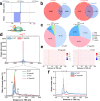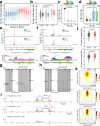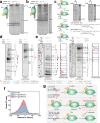Nascent RNA sequencing identifies a widespread sigma70-dependent pausing regulated by Gre factors in bacteria
- PMID: 33568644
- PMCID: PMC7876045
- DOI: 10.1038/s41467-021-21150-2
Nascent RNA sequencing identifies a widespread sigma70-dependent pausing regulated by Gre factors in bacteria
Abstract
Promoter-proximal pausing regulates eukaryotic gene expression and serves as checkpoints to assemble elongation/splicing machinery. Little is known how broadly this type of pausing regulates transcription in bacteria. We apply nascent elongating transcript sequencing combined with RNase I footprinting for genome-wide analysis of σ70-dependent transcription pauses in Escherichia coli. Retention of σ70 induces strong backtracked pauses at a 10-20-bp distance from many promoters. The pauses in the 10-15-bp register of the promoter are dictated by the canonical -10 element, 6-7 nt spacer and "YR+1Y" motif centered at the transcription start site. The promoters for the pauses in the 16-20-bp register contain an additional -10-like sequence recognized by σ70. Our in vitro analysis reveals that DNA scrunching is involved in these pauses relieved by Gre cleavage factors. The genes coding for transcription factors are enriched in these pauses, suggesting that σ70 and Gre proteins regulate transcription in response to changing environmental cues.
Conflict of interest statement
The authors declare no competing interests.
Figures






Similar articles
-
Early transcriptional arrest at Escherichia coli rplN and ompX promoters.J Biol Chem. 2009 Dec 18;284(51):35702-13. doi: 10.1074/jbc.M109.053983. J Biol Chem. 2009. PMID: 19854830 Free PMC article.
-
The σ24 Subunit of Escherichia coli RNA Polymerase Can Induce Transcriptional Pausing in vitro.Biochemistry (Mosc). 2019 Apr;84(4):426-434. doi: 10.1134/S0006297919040102. Biochemistry (Mosc). 2019. PMID: 31228934
-
Structural transitions in the transcription elongation complexes of bacterial RNA polymerase during σ-dependent pausing.Nucleic Acids Res. 2012 Apr;40(7):3078-91. doi: 10.1093/nar/gkr1158. Epub 2011 Dec 2. Nucleic Acids Res. 2012. PMID: 22140106 Free PMC article.
-
The yin and yang of the universal transcription factor NusG.Curr Opin Microbiol. 2024 Oct;81:102540. doi: 10.1016/j.mib.2024.102540. Epub 2024 Sep 2. Curr Opin Microbiol. 2024. PMID: 39226817 Review.
-
General pathway for turning on promoters transcribed by RNA polymerases containing alternative sigma factors.J Bacteriol. 2006 Jul;188(13):4589-91. doi: 10.1128/JB.00499-06. J Bacteriol. 2006. PMID: 16788165 Free PMC article. Review. No abstract available.
Cited by
-
Identification of a Rho-Dependent Termination Site In Vivo Using Synthetic Small RNA.Microbiol Spectr. 2023 Feb 14;11(1):e0395022. doi: 10.1128/spectrum.03950-22. Epub 2023 Jan 18. Microbiol Spectr. 2023. PMID: 36651730 Free PMC article.
-
Robust regulation of transcription pausing in Escherichia coli by the ubiquitous elongation factor NusG.Proc Natl Acad Sci U S A. 2023 Jun 13;120(24):e2221114120. doi: 10.1073/pnas.2221114120. Epub 2023 Jun 5. Proc Natl Acad Sci U S A. 2023. PMID: 37276387 Free PMC article.
-
Structural and mechanistic basis of σ-dependent transcriptional pausing.Proc Natl Acad Sci U S A. 2022 Jun 7;119(23):e2201301119. doi: 10.1073/pnas.2201301119. Epub 2022 Jun 2. Proc Natl Acad Sci U S A. 2022. PMID: 35653571 Free PMC article.
-
Loss of Gre factors leads to phenotypic heterogeneity and cheating in Escherichia coli populations under nitric oxide stress.mBio. 2024 Oct 16;15(10):e0222924. doi: 10.1128/mbio.02229-24. Epub 2024 Sep 9. mBio. 2024. PMID: 39248572 Free PMC article.
-
Gre Factors Are Required for Biofilm Formation in Salmonella enterica Serovar Typhimurium by Targeting Transcription of the csgD Gene.Microorganisms. 2022 Sep 27;10(10):1921. doi: 10.3390/microorganisms10101921. Microorganisms. 2022. PMID: 36296197 Free PMC article.
References
Publication types
MeSH terms
Substances
LinkOut - more resources
Full Text Sources
Other Literature Sources
Molecular Biology Databases
Research Materials

